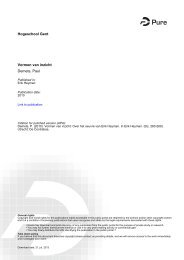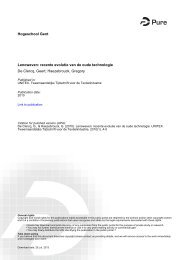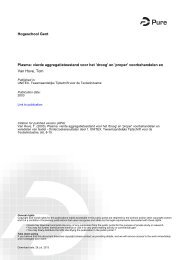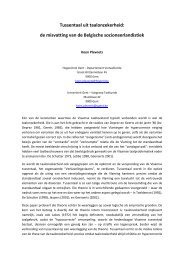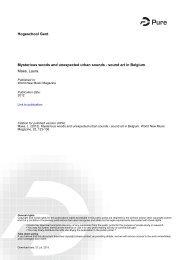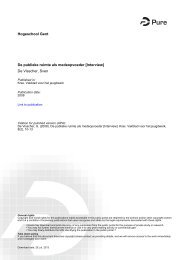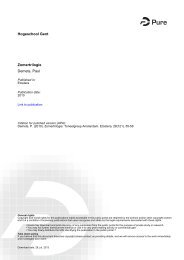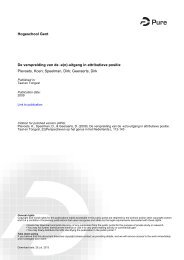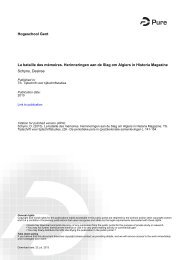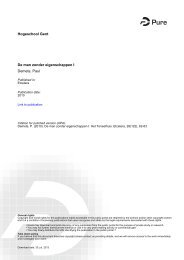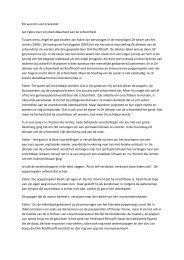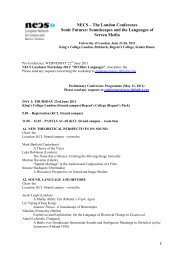PhD Vermeiren Lieve Compleet - Hogeschool Gent
PhD Vermeiren Lieve Compleet - Hogeschool Gent
PhD Vermeiren Lieve Compleet - Hogeschool Gent
You also want an ePaper? Increase the reach of your titles
YUMPU automatically turns print PDFs into web optimized ePapers that Google loves.
undissociated acid molecules enter a microbial cell, at the higher intracellular pH, they<br />
dissociate in charged anions and protons, both unable to diffuse out of the cell thus reducing<br />
the intracellular pH (Eklund, 1989; Russell, 1992). A low cytoplasmic pH causes structural<br />
changes in proteins, nucleic acids and phospholipids, influences rates of enzyme action and in<br />
this way interferes with essential metabolic functions and prevents active transport requiring a<br />
ΔH + -gradient (Eklund, 1989; Stratford, 2000). To maintain or raise internal pH, a<br />
compensating transport of protons out of the cell takes place by membrane-bound H + -<br />
ATPases but consumes excessive ATP (Stratford, 2000). The remaining anion inside the cell<br />
can be driven to the outside of the cell by the electrochemical gradient. The anion is<br />
protonated again to repeat the cycle until the proton motive force is dissipated and the cell is<br />
inhibited by energy depletion (Eklund, 1989; Russell, 1992; Stratford, 2000). The last decade,<br />
however, the organic acids are regarded as having not one but several mechanisms of action<br />
and inhibition of active<br />
nutrient transport by<br />
neutralisation of the<br />
proton motive force only<br />
XCOOH XCOOH<br />
is not believed to fully<br />
explain their<br />
XCOO<br />
antimicrobial activity<br />
(Eklund, 1989; Russell,<br />
1992). Lactic acid is<br />
acting partly according<br />
Figure 1.3. Weak acid theory and dissipation of the proton to the weak acid theory,<br />
motive force (modified from Russell, 1992 and Stratford, 2000) but other mechanisms of<br />
inhibition are also involved (Eklund, 1989; Bogaert & Naidu, 2000; Stratford, 2000).<br />
Furthermore, it has been shown that the effects of lactic acid on microbial growth at different<br />
pH can only be explained if both the undissociated and the dissociated form are taken into<br />
account (Gonçalves et al., 1997). Organic acids have a wide inhibitory spectrum including<br />
Gram-positive and Gram-negative bacteria, yeasts and moulds. Lactic acid mainly acts<br />
against bacteria and is ineffective against yeast and moulds (Eklund, 1989; Bogaert & Naidu,<br />
2000). Lactic acid and its salts are reported to have an inhibitory effect on LAB (Houtsma et<br />
al., 1993), spore-forming Clostridia and Bacillus spp. (Bogaert & Naidu, 2000), Listeria<br />
monocytogenes (Houtsma et al., 1993) as well as on Gram-negative pathogens such as E. coli<br />
0157:H7 and Salmonella spp. This property makes organic acids attractive food preservatives.<br />
-<br />
H +<br />
XCOO -<br />
H +<br />
ADP + Pi<br />
ATP<br />
H +<br />
Chapter 1 – Antagonistic micro-organisms for biopreservation of food products 10



